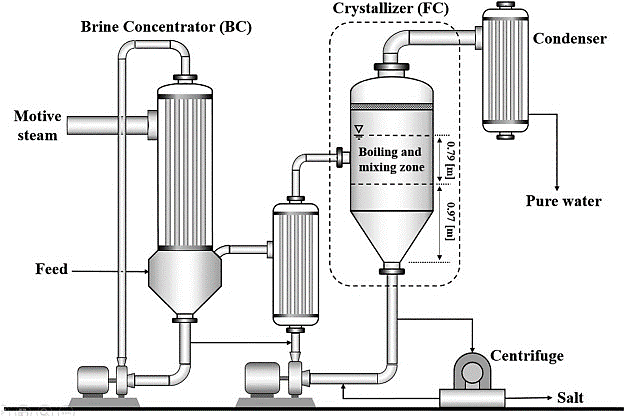
Crystallization is a physical change. Crystallization is the formation of solids from the liquid or gaseous phase. This technique includes obtaining the crystals of a soluble substance from a hot saturated solution and separating the soluble solid from the solution.
To concentrate feed into solid crystals and clean water, crystallizers are used. A progressively harder method for which crystallite sizes are formed from a liquid solution is known as crystallization. Crystallizers can remove liquid wastes completely, resulting in no liquid discharge (ZLD). The process continues and secondary crystallization are the two stages of crystallization. The formation of new crystals is referred to as primary nucleation. Secondary nucleation is the primary stage that results in the mass production of crystals. There are two types of crystallization processes: evaporative crystallization and cooling crystallization.
Main nucleation and secondary nucleation are The 2 steps while in the crystallization course of action. New crystals advancement is called Principal nucleation. Secondary nucleation is the foremost phase that results in the bulk development of crystals and is what retains development likely.
We then elucidated the criterion of crystallizability and showed how it is determined by salt species, membrane Houses and functioning problems. Last of all, we analysed the Power usage of the EDC-reverse osmosis procedure practice for obtaining zero liquid discharge of a Na2SO4 brine. All round, this examine supplies a evidence of concept for EDC as An electrical-subject pushed and non-evaporative crystallization process, and lays the muse for its foreseeable future technical growth and optimization.
Publisher’s note Springer Character stays neutral regarding jurisdictional claims in revealed maps and institutional affiliations.
As we know, the evaporator can also be suitable for salt Restoration from superior-salinity brine. However, it is vitally uncomplicated for salt to crystallize around the evaporator floor and inside the drinking water channel even though managing large-salinity brine. The effectiveness of photothermal conversion along with the drinking water transportation effectiveness of evaporators will lessen resulting from salt accumulation [22,23]. Thus, enabling an evaporator to acquire durable water evaporation efficiency is vital to analysis all through salt Restoration.
The supersaturation filling process could be achieved by cooling the answer but with negligible or slight evaporation.
Evaporation, is accomplished by heating the mother liquid or lowering the stress within the vessel to produce a boiling zone at the best. This can be utilized for a variety of systems, albeit it consumes far more Strength than cooling.
While using the purpose of no cost control of the outer condition and interior h2o transportation channel with the evaporator, seawater evaporation crystallizers ended up produced by 3D-printing technology With this examine. The crystallizer framework is made of two components: (one) the very best photothermal conversion layer, which looks as if a sloping roof; and (two) The underside cube for water transfer. Furthermore, the supporting buoyancy layer construction was created to offer buoyancy for the crystallizer body and the good salt collected. The photothermal conversion part was printed with Polylactic acid (PLA)/bio carbon composite filaments. The h2o transfer cube was printed with pure PLA filaments.
We hypothesize the followings being a possible mechanism for forming the area dense crust layers and inner pore filling crystals in the situation of the concentrated SWRO brines. Since the salt precipitates during water evaporation, NaCl, as quite possibly the most plentiful species, precipitates dominantly even though highly hydrous magnesium sulfate, like a minimal species, precipitates only during the gap Area One of the cubic NaCl crystals. As being the hydrous magnesium sulfate gradually fills the pore Area One of the NaCl crystals, at just one issue, a dense crust layer is fashioned on the surface, which renders the evaporation substrate unable to deliver water to the outer surface and thus water evaporation stops.
The whole process of vacuum crystallizers is sometimes made use of like a continuous and from time to time as a group. In field, batch vacuum crystallizers are more well-liked than constant vacuum crystallizers.
The competitive advantage of the outer surface in salt precipitation keeps the interior facet of the membrane freed from salt crystals (Fig. 3d) and maintains the h2o channel In the QGF membrane unobstructed.
Immediately after cooling and salt extraction, the residual brine liquor features a reduced dissolved salt information (~ten%) and may be warmed up and recycled once again with the UHP-RO system. A heat pump is used to simultaneously great one particular Element of the circuit while heating one other — presenting appreciable Electricity efficiency personal savings.
Fig. three. Solar evaporation and crystallization actions of brines. a The evaporation charge (ER) of 24 wt% NaCl brine and actual seawater brines within the 24-h Procedure; pics of the photo voltaic crystallizers following the 24-h Procedure utilizing b 24 wt% NaCl brine and c concentrated RO squander brine; SEM illustrations or photos in the inner aspect of QGF membrane soon after working with d 24 wt% NaCl brine and e concentrated Crystallizer Manufacturer Crystallizer For Zero Liquid Discharge System real RO squander brine; f the IR illustrations or photos on the photo voltaic crystallizer even though treating concentrated RO squander brine.
The whole process of vacuum crystallization entails a combination of evaporation and cooling when the answer is put less than vacuum conditions, on account of which the solvent suddenly evaporates and cools the answer as a result of an adiabatic process.
six wt% outside. It seems that the array delivered a high drinking water evaporation amount of forty eight.0 kg m−two, exhibiting its great prospective for practical brine treatment. Underneath the field problems, the photo voltaic incident angle, ambient temperature, relative humidity and pure wind all have an effect on the efficiency from the solar crystallizer. In depth evaluation of these types of effects is essential for the practical application of the solar crystallizer in the direction of functional ZLD brine treatment.